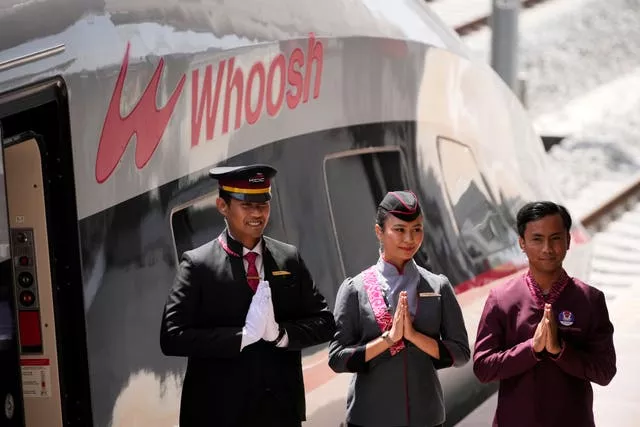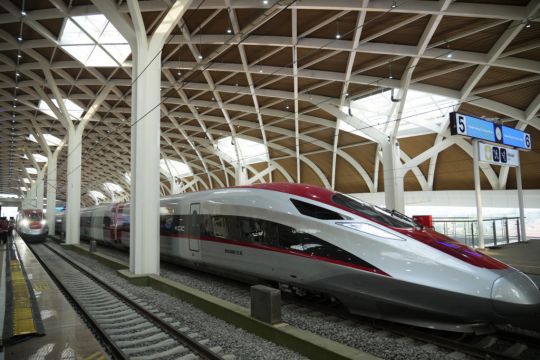South-east Asia’s first high-speed railway was launched on Monday as it is set to begin commercial operations.
It is a key project under China’s Belt and Road infrastructure initiative that will drastically reduce the travel time between two key cities.
The project has been beset with delays and increasing costs, and some observers doubt its commercial benefits. But Indonesian President Joko Widodo has championed the 88-mile railway, which was issued its official operating licence from the country’s Transportation Ministry on Sunday.

The 7.3 billion US dollar (£5.99 billion) project, largely funded by China, was constructed by PT Kereta Cepat Indonesia-China, known as PT KCIC, a joint venture between an Indonesian consortium of four state-owned companies and China Railway International.
The railway connects Jakarta with Bandung, the heavily populated capital of West Java province, and will cut travel time between the cities from the current three hours to about 40 minutes.
Its use of electrical energy is expected to reduce carbon emissions.
Mr Widodo in his opening remarks officially named Indonesia’s first high-speed railway — the fastest in Southeast Asia, with speeds of up to 217mph — as “Whoosh,” from “Waktu Hemat, Operasi Optimal, Sistem Handal,” which means “timesaving, optimal operation, reliable system” in Indonesian language.
“The Jakarta-Bandung high-speed train marks the modernisation of our mass transportation, which is efficient and environmentally friendly,” Mr Widodo said.

“Our courage to try new things gives us confidence and the opportunity to learn and will be very useful for the future, making our human resources more advanced and our nation more independent,” he added.
Mr Widodo, along with other high-ranking officials, rode Whoosh from its first station, Halim in eastern Jakarta, to Bandung’s Padalarang station, one of the line’s four stations, located about 18 miles from the central area of Bandung.
He took a 25-minute test ride on the train on September 13 and told reporters that he felt comfortable sitting or walking inside the bullet train even at its top speeds.
Chinese Premier Li Qiang took a test ride early last month while visiting Jakarta for three days of talks with leaders of the Association of South-east Asia Nations and other countries.
Luhut Binsar Pandjaitan, the co-ordinating minister for maritime and investment, said China Railway has agreed to transfer its technology to Indonesia so that in the future the country’s high-speed trains can be made domestically.
For two weeks leading up to the inauguration, PT KCIC has been running a free-of-charge public trial.

Indonesia broke ground on the project in 2016. The line was originally expected to begin operations in 2019, but was delayed by disputes over land acquisition, environmental issues and the Covid-19 pandemic. It was planned to cost 66.7 trillion rupiah (£3.53 billion), but the amount ballooned to 113 trillion rupiah (£92.67 billion).
The trains have been modified for Indonesia’s tropical climate and are equipped with a safety system that can respond to earthquakes, floods and other emergency conditions. The 209-metre train has a capacity of 601 passengers.
Ticket prices had not been finalised as of Monday, but PT KCIC estimated one-way prices per passenger would range from 250,000 rupiah (£13) for second class to 350,000 rupiah (£18.50) for VIP seats.
Passengers going to Bandung city centre need to take a feeder train from the Padalarang station that will add a further 20 minutes, with an estimated cost of about 50,000 rupiah (£41,000).
The rail deal was signed in October 2015 after Indonesia selected China over Japan in fierce bidding. It was financed with a loan from the China Development Bank for 75% of the cost. The remaining 25% came from the consortium’s own funds.
The project is part of a planned 466-mile high-speed train line that would cut across four provinces on Indonesia’s main island of Java and end in the country’s second-largest city, Surabaya.
As a global economic giant, China is one of the largest sources of foreign direct investment in south-east Asia, a region home to more than 675 million people. Amid crackdowns by the United States and its allies, China is expanding trade with ASEAN countries and infrastructure projects are playing key roles.







